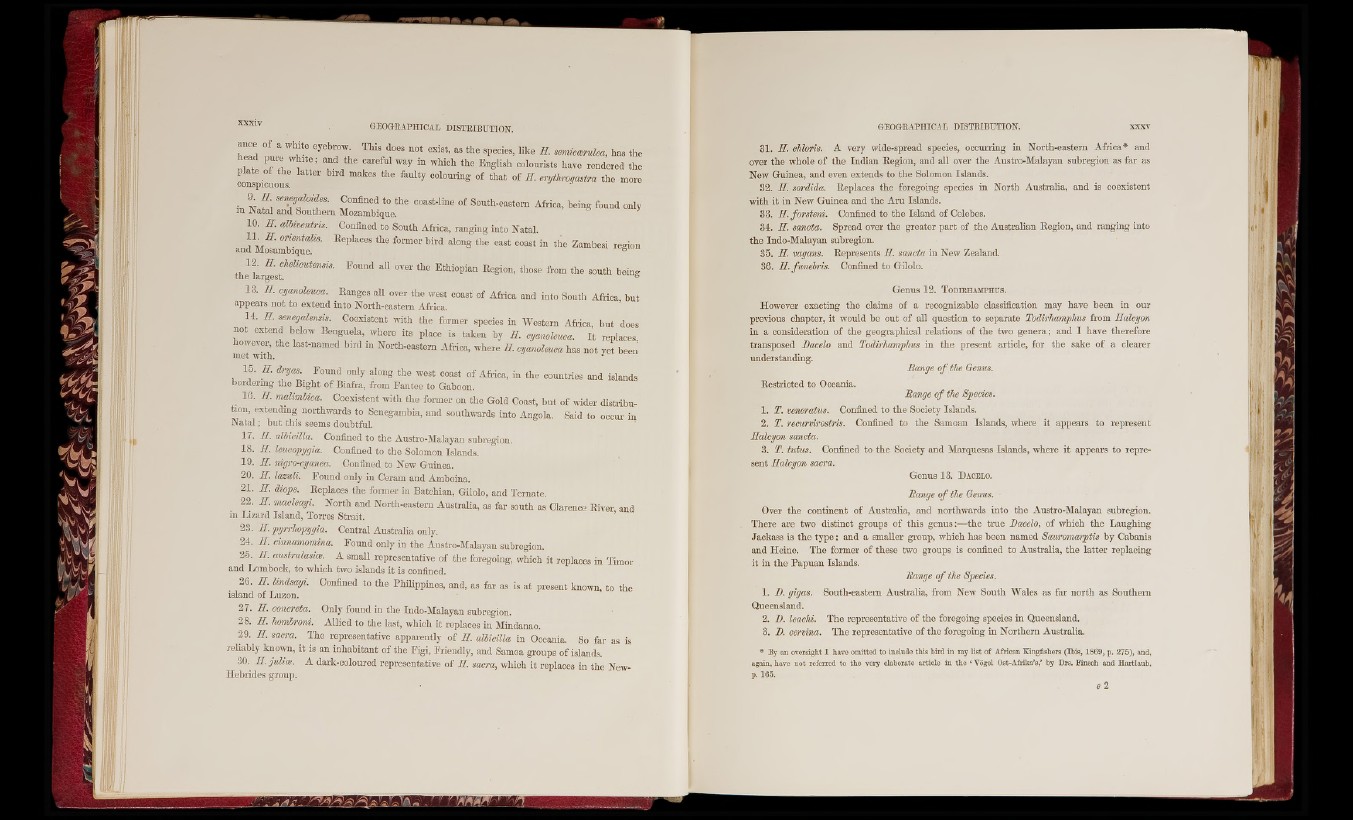
I. !l|
|i Wi
' ï â :
xxxiv
h e ad p u re wht e ; and th e careful way in which th e E n glish colourists have rendered the
c o n sp icL u s ' “ '^'■3'*'™#«*«™ üre more
In N f ; Cou fiu ei to th e coast-line o f South-eastern Africa, b eing found only
in JNatal and S outhern Mozambique.
10. I I . alUventrh. Confined to South Africa, ranging in to Natal.
and M o tm “ ^ g io n
th e those from the south being
13. I I. a jamUuca. Ranges aU over th e west coast o f Africa and into South Africa b u t
appears n o t to ex ten d into North-eastern Africa.
U . H . eenegaUnsie. Coexistent with the former species in Western Africa, b u t does
n o t extend below Benguela, where its place is tak en by I I. oganolettca. I t replaces
m e ! with “ North-eastern Africa, where II. oyanolmoa has n o t yet been
15. II. dryas. F o u n d only along th e west coast o f Africa, in th e countries and islands
bordermg th e B ig h t o f Biafra, from Fan tee to Gaboon.
16. II. malimbica. Coexistent with th e former on the Gold Coast, b u t o f wider d istribution,
oxtendmg n orthwards to Senegambia. and southwards into Angola, Said to occur in
iMatal; b u t th is seems doubtful.
17. I I. albicilla. Confined to th e Austro-Malayan subregion.
18. I I. leucopygia. Confined to th e Solomon Islands.
19. I I . nigro-cyanea. Confined to New Guinea.
20. I I. lazuli. Fo u n d only in Ceram and Amhoina.
21. I I. diops. Replaces the former in Batchian, Gilolo, and Ternate.
22. I I . macleayi. N o rth and North-eastern AnstraUa, as far south as Clarence River and
in Lizard Island, Torres Strait. ’
23. I I. pyrrhopygia. Central Australia only,
24. H. dmiamomina. F o u n d only in th e Austro-Malayan subregion.
25. I I. australasioe. A small representative o f th e foregoing, which it replaces in Timor
and Lombock, to which two islands it is confined.
26. I I. lindsayi. Confined to the Philippines, and, as far as is a t present known, to the
island o f Luzon.
27. H . concreta. Only found in tb e Indo-Malayan subregion.
28. I I. hombroni. Allied to the last, which i t replaces in Mindanao.
29. I I. sacra. T h e representative apparently o f I I. albicilla in Oceania, So far as is
reliably known, it is an in h ab itan t o f th e Figi, Friendly, and Samoa groups o f islands.
30. IL ju lioe . A dark-coloured representative o f I I. sacra, which it replaces in the Now-
Hebrides group.
31. H. chloris. A very wide-spread species, occurring in Nortb-eastern Africa* and
over th e whole o f th e In d ian Region, and all over th e Austro-Malayan subregion as far as
New Guinea, and even extends to th e Solomon Islands.
32. I I. sordida. Replaces the foregoing species in No rth Australia, and is coexistent
with i t in New Guinea and the A ru Islands.
33. H. fo rsten i. Confined to th e Island o f Celebes.
34. II. sancta. Spread over the greater p a rt o f th e Australian Region, and ranging into
th e Indo-Malayan subregion.
35. II. vagans. Represents II. sancta in New Zealand.
36. H. funehris. Confined to Gilolo.
Genus 12. ToDiEHAMPnus.
However exacting th e claims o f a recognizable classification may have been in our
previous chapter, i t would be out o f all question to separate Todirhamphus from Halcyon
in a consideration o f the geographical relations o f th e two g e n e ra ; and I have therefore
transposed Dacelo and Todirhamphus in tb e present article, for th e sake o f a clearer
understanding.
Restricted to Oceania.
1. T. veneratus. Confined to tbe Society Islands.
2. T. recurvirostris. Confined to the Samoan Islands, where it appears to represent
Halcyon sancta.
3. T. tuüis. Confined to th e Society and Marquesas Islands, where i t appears to represent
Halcyon sacra.
Genus 13. D acelo.
Range o f the Genus.
Over tb e continent o f Australia, and northwards into th e Austro-Malayan subregion.
There are two distinct groups o f this g e n u s :—tb e tru e Dacelo, o f which the Laughing
Jackass is tbe ty p e ; and a smaller group, which has been named Sauromaiptis by Cabanis
and Heine. Tbe former o f these two groups is confined to Australia, the latter replacing
it in th e P ap u an Islands.
Range o f the Species.
1. D. gigas. South-eastern Australia, from New South Wales as far n orth as Southern
Queensland.
2. D. leachi. T h e representative o f tb e foregoing species in Queensland.
3. D. cervina. T h e representative o f th e foregoing in North ern Australia.
* By an oversight I have omitted to inclndo this bird in my list of African Kingfishers (Ibis, 1869, p. 275), and,
again, have not referred to the very elaborate article in the ‘ Vogel Ost-Afrika’s,’ by Drs. Finsch and Hartlaub,
p. 165.